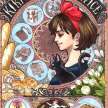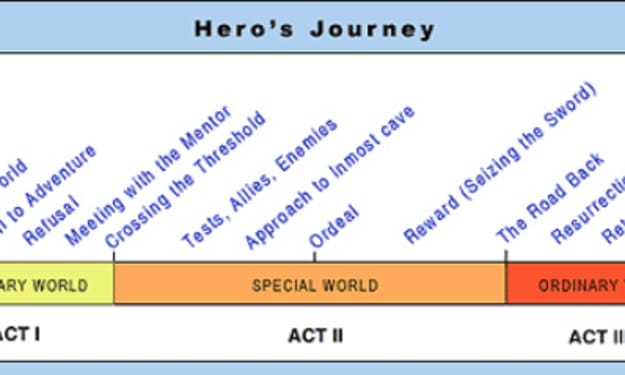
Here we are! ACT 2—now, act two could easily be called the meat of the story. It's where all the chaos, challenges and near death experiences happen. It's also where your protagonist or "Hero" experiences their change. It's not a complete change until ACT 3, but the experiences they have in the new world play a key role.
"Crossing the Threshold" sort of falls right in the middle. If you're writing a script for a movie or television, this point in time there will be a break just before embarking on the adventure itself. In The Hobbit, Bilbo joins the adventure, but he doesn't see a different world than the one he knows until he's face to face with the trolls. It's at this point that Bilbo realizes that the world is not all gardens, tea trolleys and quiet days. Trolls want to eat him and his friends. It's also a test, so it merges into the next section of the act.
1. Tests, Allies and Enemies
This is more of a expansive section- it will begin with a test such as the Troll test Gandalf so lovingly provides, while being completely uninvolved in the whole thing until the very end when the sun comes up and CRACK he breaks the rock, sun shines in and turns the Trolls to stone. Gandalf, sneaky as he is, uses the test to show Bilbo that he is smart and witty, he's the only one who decided to bide for time. Bilbo has MANY other tests and they can happen at ANY point during ACT 2, except before "Reward," because at that point there has to be some relief. Of course, your protagonist can just get a horrible ride the whole way, if you so choose. Your hero will have tests that will challenge his commitment, gain allies to help on his journey or like Bilbo you will have allies initially but be greeted by another who has information, such as Radagast. These are puzzles compared to the challenges that await your hero.
Bilbo meets Gollum during his tests, allies and enemies event. Gollum drops something which becomes handy to Bilbo later, and it sets the stage for Gollum in the future. His role with Frodo.
The reason for tests, allies and then reward at the end is because a hero needs something to keep him going. Something to work towards. Even a Hero doesn't do something for nothing. Robin Hood robbed the rich and gave it to the poor, BUT it also annoyed the snot out of Nottingham. A plus for Robin. Heroes have goals, wants and needs. Aragorn for example, he needs to know that he isn't weak like his ancestor who initially kept the one ring. Aragorn fears this, he knows that the blood that ran through Isildur also runs through him. Tolkien mentions in his book that the ring calls out to Aragorn, and you see this briefly in the first film. Frodo knows that men are too weak to ignore the ring's call. Aragorn despises his ancestors and doesn't want to acknowledge his relation to them. However, through a series of trials, challenges and near death experiences Aragorn learns that he's stronger than he thinks. Its through the hardship that he learns what a King he can be, and how his strength will keep his people safe. Amazing right?
2. Approach the Inmost Cave
This one is a little squiggly. It's useful in most stories, but in others, like Romance novels, it may serve little purpose. Essentially, the hero has gone through trials and errors and has come out surprisingly okay. The Approach is the next set of challenges, which the hero may fail, lose a friend or ally and in general feel completely lost. It's a bit like realizing that, in order to win, you have to think like your enemy without actually becoming your enemy, but that task alone is hard enough. The hero is fully committed after the end of tests, allies and enemies. In turn the attempts to kill or defeat your hero will be turned up to 10. Someone might die, the hero may lose something valuable or gain something only to have it be lost to him. In Bilbo's story this might be when he leaves the dwarves and returns to Gandalf. He loses a friend, he's become the enemy and is forced out. Thorin is consumed and turned by the gold in his castle. Especially now that Smaug has been defeated. Bilbo is worried for his friend, and Azog still wants Thorin dead. It turns into this huge battle between dwarves, humans and elves and eventually is interrupted by Azog.
3. Ordeal
This is the climax of the story. This is when the real heat goes down, when swords clash and the end battle begins. The hero versus the villain. Finally, after lots of events, dodging and near death, these two finally meet on the same battlefield. In The Hobbit, this is the battle Thorin has with Azog. The battle itself against the Orc army is an ordeal for Gandalf and other party members as well. Unfortunately, Thorin dies, and for Bilbo, this is a great loss, especially because the terms they left each other on were not great. There is some solace during Thorin's death scene though. "I wish to part from you in friendship," sigh... makes me cry every time. WHY? Because throughout this whole story, this whole ordeal you've seen the friendship build between Thorin and Bilbo. Halfway through the second movie Thorin even becomes protective of Bilbo. Remember that The Hobbit is one singular book, but it was split into three films. The bond that has grown between them has occurred during the trials and challenges they have both come to face. So when he death hits, it hits hard. This is why establishing a good outline before the climax is so critical. The readers need to love your hero's allies. Even though the book is called The Hobbit, essentially Bilbo's story is more like a secondary storyline to Thorin's. The two compliment each other quite well, and for a brief moment, Thorin actually becomes an Antagonist in Bilbo's story, only to be reunited once again as friends.
4. Reward
This can be anything. It depends on what your story is about, what genre and who is in it. For Bilbo, it was ending a war, saving what dwarf friends he had left and returning Erebor to Thorin's family. Dain II Ironfoot becomes King under the Mountain and so Bilbo has successfully returned the mountain and its treasure back into the dwarves hands. He also had an adventure, made friends and saw the world in a completely different way. You'll also hear him tell Frodo, "I got a chest of gold that still smells of troll" because they found the swords and gold after the trolls turned to stone in the beginning of the film.
After this you go into ACT 3: It's fairly short so we'll cover it here.
ACT 3: The Ordinary World
Basically at this point the challenges are gone, the battle has been won and now it's time to make your way home back to the world you knew before.
This can be used several different ways. If your story is a series and it will go into another book or a continuation of the same story then you'll leave off after the Reward. There was some goal in your first book, you've completed that, and earned the reward but there's no going back home because the story isn't over. In Bilbo's case, his story is over and so he takes the journey back home. You can explain this in detail, letting the reader know the thoughts and feelings of your hero. Or you can simply state that they returned home.
5. Resurrection
Alternatively, if you want to follow the hero's journey to a "t" then your hero will survive his ordeal, gain the reward and then encounter another obstacle. Sometimes this is where he takes everything he has learned throughout his entire journey and uses it for this one challenge. The Ordeal could be your climax if you intend for no other challenges to be present for your hero afterwards. If not, then the Ordeal would serve as a battle but not the final battle. RESURRECTION would serve as your climax in that case.
Bilbo has no other ordeals after the huge battle. You could look at it as the war between dwarves and humans is the ORDEAL and the fight with AZOG is the climax.
Watching films and the time stamps can help you determine at which point in the story you are at. Writing an outline can be extremely helpful too.
6. Return with the Elixir
This is when your hero is finally home. He's returned to the way life once was and finds peace in it. Bilbo loves Bag-End and he's happy to be home; however, he still has the ring, and that lays the land for another story later—which is the Resurrection in Bilbo's story. It's one that isn't fulfilled in "The Hobbit" but instead comes later for Bilbo.
Using the Hero's journey can really help lay out your story and provide a steady stream of events that shape and challenge your characters. You don't have to use every single stage, but they do usually work in unison. As mentioned before, Romance, Drama or Fiction novels may or may not use all stages.
A romance novel will use these stages differently, and they will mean slightly different things. Same as a fiction story. They are still useful and will help you create a sturdy outline.
I'll write an article on Outline's but briefly, remember that your story is not just your outline. Your outline is the backbone of your story, it's the A to B part, but along the way your hero can encounter several other things. The story might veer off, but it will always come back to the outline.
Happy Writing!
About the Creator
Shiny
I am a writer, author and painter. I have a Master's degree in Creative Writing and love writing about all kinds of topics.






Comments
There are no comments for this story
Be the first to respond and start the conversation.